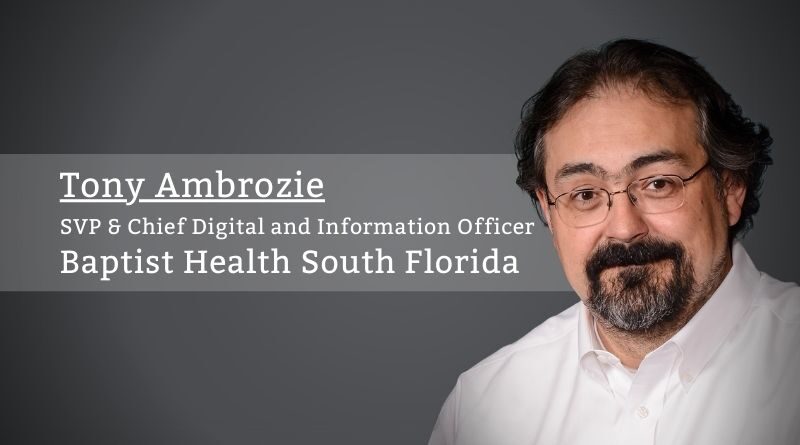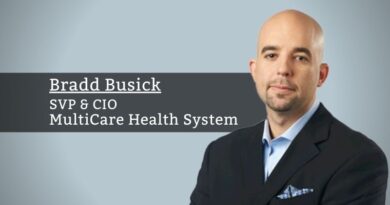Positioning Healthcare Providers for the Digital Age
By Tony Ambrozie, SVP & Chief Digital and Information Officer, Baptist Health South Florida
One of the most significant changes facing healthcare providers today is digital transformation. One hospital system CEO described the digital transformation as having even more of a long-term impact than the COVID-19 pandemic. To succeed in this endeavor, healthcare providers need to ensure they are focusing on the right dimensions that integrate the entire ecosystem, incorporate the right technologies and plan appropriately to avoid potential pitfalls during the journey.
The cloud is not merely someone else’s compute and storage, though that brings improved cost, provisioning, and management at a level of sophistication hard to replicate on-premise.
So, what does “digital transformation” mean exactly? It’s one of the most elusive of terms. It really means changing and transforming the business and operational models by using digital and data technologies (aka digital). So, while digital transformation does not mean just technology, technology is critical.
While digital looks very easy from a distance, especially when done well, it requires relentless attention to detail on both the user experience and the back of house operations to create a seamless and useful digital experience. As such, digital initiatives for healthcare providers must focus on four experiential dimensions:
- Consumers (pre- and post-visit) – think basic items like the ease of booking and changing appointments, and more complex solutions like remote health monitoring and personalized medicine.
- Patients (During clinical interactions) – including ease of check-in, digital experiences in hospitals and clinics, and telehealth options.
- Clinical Staff (Physicians and Nurses) – this includes digital tools and experiences to allow the staff to spend most of their time focusing on patients rather than administrative work.
- Business (Operations and administration) – centered on tools to make operations more efficient through automation, data analytics, and machine learning
In order to seamlessly integrate these dimensions, innovative technologies are going to be game-changers. The adage that says you can’t solve tomorrow’s problems with the tools you used to create them is very applicable here. Three sets of technologies stand out: the cloud, machine learning (ML), and remote sensors.
The cloud is not merely someone else’s compute and storage, though that brings improved cost, provisioning, and management at a level of sophistication hard to replicate on-premise. The cloud ecosystem offers benefits and solutions that can solve some of the health care industry’s greatest challenges.
- Flexibility and speed to the market allow tenants to quickly innovate and tune solutions to meet consumer’s reactions, as well as sudden events such as the ones driven by the pandemic. When combined with agile development, cloud speed will go a long way towards solving healthcare IT’s perception as being slow and non-responsive to consumer needs.
- The cloud offers an ecosystem that can be quickly incorporated into the systems’ own solutions – such as increasingly sophisticated “automatic” machine learning model selection. This allows for new technologies to be plugged in, helping solve issues that have existed for a while.
- Not without its downside, migration from on-premise tends to be costly and comes with some risk, so strategically building the plan and ensuring readiness is critical.
Machine learning-based predictive and prescriptive analytics have long held the promise of better outcomes in medical treatments. These analytics pave the way for efficiencies through optimization of operating rooms, clinicians, staff scheduling, and more personalized recommendations and care. Fortunately, the science and the technologies behind it are becoming widely available and relatively inexpensive, especially in the cloud.
Tempering the promise of ML are a number of challenges:
- Business users don’t fully understand and trust the value of ML recommendations. As such, a show-and-prove tactic is critical for adoption.
- The old problem of data quality still exists, and data cleansing must continue to be a big focus. However, non-glorious may be.
- “Injecting” the recommendation into all systems and applications is the bulk of the work and thus the cost as well.
- On the positive side, the old fallacy of “you need lots of PhDs to do data science” has mostly been debunked by reality. What is needed are people who understand how to use the widely available models and the still too complex technology stack.
Finally, the remote video doctor-patient interactions that skyrocketed in number during the pandemic is just one sign of the upcoming remote and home care trend, mostly based on real-time sensors and sensor management platforms. True health care doesn’t only happen when you talk to a doctor. And while IoT and at-home sensors are still not as robust as we’d like, the biggest challenge to the transformation is not technology, but legacy business, incentives, and operational models.
Cloud, Machine Learning, and IoT technologies are not just topics for the CIO to talk about, but true business capabilities that the CEO must understand and support to fully realize the benefits they can bring.
I see two major and positive trends in new technologies; large technology vendors entering the healthcare sector and startups and small vendors providing innovative capabilities.
Major cloud providers and technology companies such as Apple, Amazon, Google, SalesForce, ServiceNow, etc. — are increasingly entering healthcare. They will provide more of the fundamental platforms and frameworks that health systems will build upon.
Many startups and smaller vendors currently providing innovative capabilities will continue to do so but in a more integrated and broad scope. There has been a tremendous amount of innovation, but it’s very use-case-specific rather than holistic solutions, even when factoring in modest EMR-integration.
We must be realistic that technology will not solve all our problems and unfortunately, will likely create new ones. For example:
- Overwhelming the customer with confusing and overly complicated digital experiences reflecting convoluted internal processes. But the solution is known: relentless attention to detail, integration at the service layer, not the presentation layer (that would lead to a patchwork of styles), good architecture, and rigorous technical implementation.
- Algorithms can be incorrectly selected, and models may be biased in various ways, which can lead to very damaging outcomes.
Healthcare is facing a once-in-a-generation transformation opportunity to make care more consumer-focused. It is incumbent upon us, the healthcare leaders, to seize the moment for that change and create a robust strategy to implement the right technology in the right dimensions. If done right, we can minimize negative impacts to our patients, consumers, and staff, while offering higher quality care at a significantly reduced cost.



